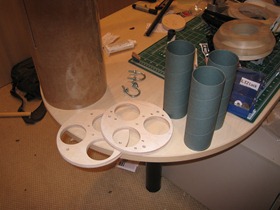
This may sound strange, but one of the main reasons I was attracted to this kit was the TRIAD AV-BAY with three separate 2.5” x 8” sealed bays for electronics. Electronics are one of my favorite parts of large rockets, and this will give me the opportunity to cram a whole lot more than normal. Longer term, I plan to use the 2.5” x 8” as a standard av-bay size so that my sled-mounted electronics can be moved from rocket to rocket without requiring any custom work, or disassembly of the electronics. Here’s the parts list for the AV-bay:
-
Six ‘O’ rings
-
One av-bay mounting ring with three 2.5” bored holes, five 5/16” pre-drilled holes, and six brass threaded inserts (bottom)
-
One av-bay mounting ring with three 2.5” bored holes, five 5/16 pre-drilled holes (top)
-
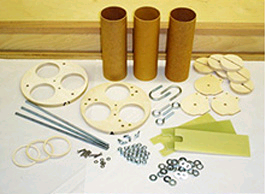 Three 2.5” x 8 phenolic tubes
Three 2.5” x 8 phenolic tubes -
Three – 1/4’ x 10.5” all-thread
-
Two – 1/4” x 20 u-bolts
-
Twenty six – 1/4” x 20 hex nuts
-
Twenty six – 1/4” washers
-
Three 1/4” eyebolts
-
Three – birch av-bay pod covers, each with two small drilled holes, one 1/4” drilled hole and three partial-circular cut outs along perimeter
-
Three 2.5” x 2.1” centering rings
-
six 2.5” x 1/4” bulkheads with dado slots
-
Three G10 boards, 2.5” x 7
-
three 1/4” x 20 wing nuts
-
six 8/32 x 3/4” machine screws
-
six 8/32 washers
As you can see, this was a comprehensive kit, with most of the major work already completed. Combined with the great set of directions Giant Leap provided, I assumed this would be a piece of cake. N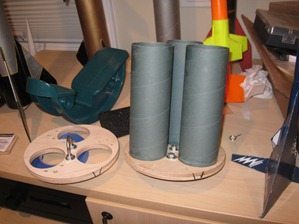 othing is ever as it seems
othing is ever as it seems ![]() Step one was to install the ubolts on each ring, then glue in place the three phenolic tubes into the top, or bottom ring. I opted to use the Hysol glue, although I knew it would be overkill for the bay. I just wanted the two hour pot time. Getting all three tubes perfectly parallel turned out to be more difficult than I expected. After a lot of trial and error, I opted to build a small jig that would keep both rings in place, while one ring dried, laying flat on a piece of teflon coated release film which I normally use for fiberglass / carbon fiber lamination. I just inverted the tubes to glue in place the second ring, ensuring the markings on the side of the rings lined up for installation of the hardware later. This could have
Step one was to install the ubolts on each ring, then glue in place the three phenolic tubes into the top, or bottom ring. I opted to use the Hysol glue, although I knew it would be overkill for the bay. I just wanted the two hour pot time. Getting all three tubes perfectly parallel turned out to be more difficult than I expected. After a lot of trial and error, I opted to build a small jig that would keep both rings in place, while one ring dried, laying flat on a piece of teflon coated release film which I normally use for fiberglass / carbon fiber lamination. I just inverted the tubes to glue in place the second ring, ensuring the markings on the side of the rings lined up for installation of the hardware later. This could have
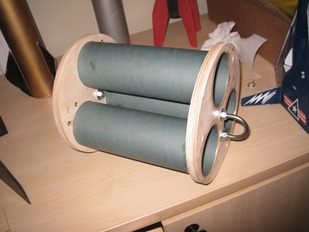
gone pretty quickly, but I typically wait the full cure time between steps. In this case, I was putting down the fillets on the rear fins, then would move to do a step on the AV-bay. After both centering rings were on, I m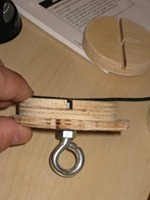 ade sure they were true, and moved to putting together the top of each pod. Oops! when putting the eyebolt through the cover, and top bulkhead with the dado slot, it became obvious the eyebolts were too small. Before going out and buying new ones, I measured EVERYTHING to ensure the bulkheads or cover’s were not cut wrong. I also email Giant Leap just to be sure. A quick stop at home depot, and I was back in business. I then threaded the eyebolts, glued t
ade sure they were true, and moved to putting together the top of each pod. Oops! when putting the eyebolt through the cover, and top bulkhead with the dado slot, it became obvious the eyebolts were too small. Before going out and buying new ones, I measured EVERYTHING to ensure the bulkheads or cover’s were not cut wrong. I also email Giant Leap just to be sure. A quick stop at home depot, and I was back in business. I then threaded the eyebolts, glued t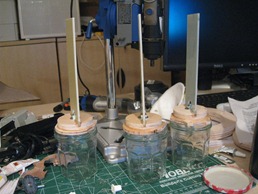 he bulkheads to the cover, and bolted them together. Once cured, I dry-fit the 3 G10 2.5” x 7” sleds into the dado slots of the bulkheads making sure there was no overhang. I then glued everything up, and left it overnight. While the glue was drying, I installe
he bulkheads to the cover, and bolted them together. Once cured, I dry-fit the 3 G10 2.5” x 7” sleds into the dado slots of the bulkheads making sure there was no overhang. I then glued everything up, and left it overnight. While the glue was drying, I installe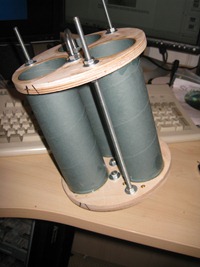 d the three all-thread rods through the two centering rings. This was actually a critical component, as the all thread would be secured through the center rings I had previously installed in the upper airframe. The main parachute kevlar shock cord would be connected to the U-bolt on the top of the av-bay, so the all thread, and center rings would be the only things connecting the main parachute to the rocket. Another great part of this hobby are the ‘cool’ tools you can buy, which could never normally be justified. In this case, my cool tool of choice was a digital toque wrench which enabled me to apply exactly the same amount of force on every bolt secured to the all-thread. In turn, th
d the three all-thread rods through the two centering rings. This was actually a critical component, as the all thread would be secured through the center rings I had previously installed in the upper airframe. The main parachute kevlar shock cord would be connected to the U-bolt on the top of the av-bay, so the all thread, and center rings would be the only things connecting the main parachute to the rocket. Another great part of this hobby are the ‘cool’ tools you can buy, which could never normally be justified. In this case, my cool tool of choice was a digital toque wrench which enabled me to apply exactly the same amount of force on every bolt secured to the all-thread. In turn, th e extreme recovery forces should be evenly distributed through the rods. At least, this is what I told my wife when she saw the bill for the tools….
e extreme recovery forces should be evenly distributed through the rods. At least, this is what I told my wife when she saw the bill for the tools….
Once the epoxy was dried on the sleds, I glued the front facing bulkhead with the dado slot on the opposite end. A few days later, I dried fit everything, and it fit quite well. I had a few areas where epoxy had overrun, or the bulkheads were too tight, but it took less than thirty minutes to get everything fit perfect. I pulled out the sleds, then CA’s the three 2.5” x 2.1” centering rings into the top of each bay. Once complete, I installed the six o rings, inserted the sleds, and locked in the three tops of the pods with two brass screws each. That was it, I now had a finished AV-bay, with the exception of mounting the electronics. Since my electronics decisions are still in flux, that may be one of the last parts of the build.
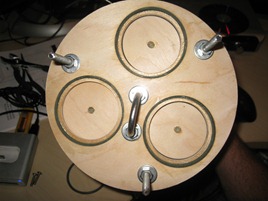
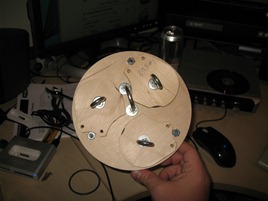

Leave a comment